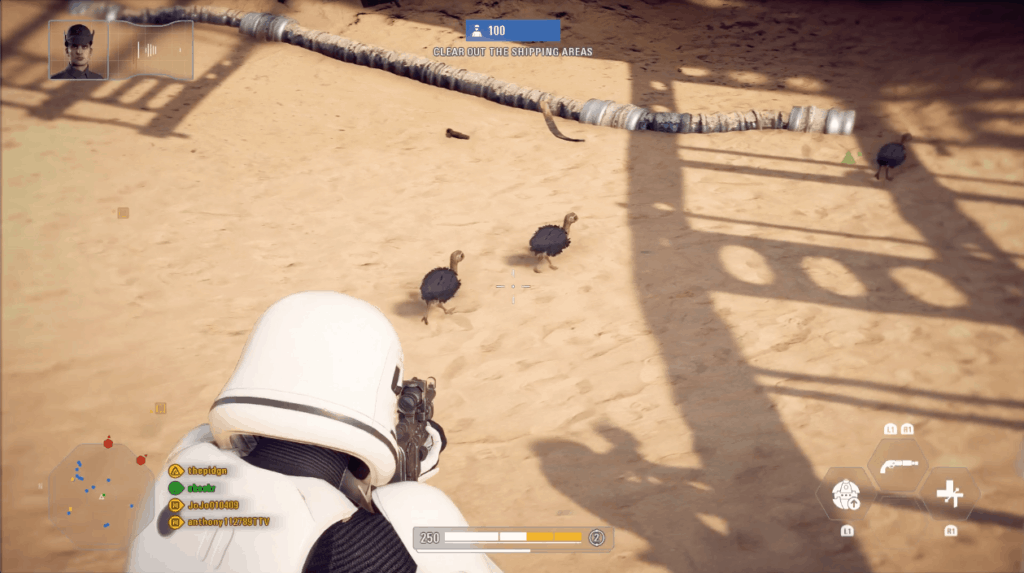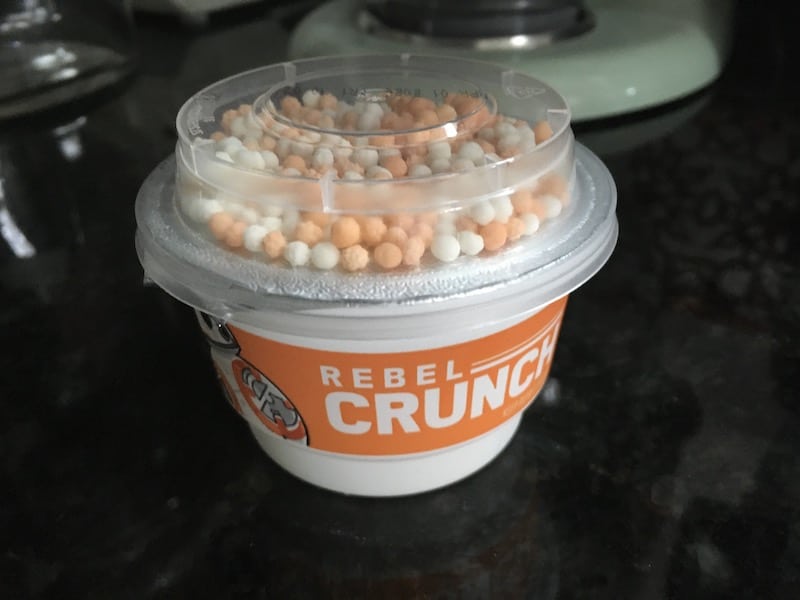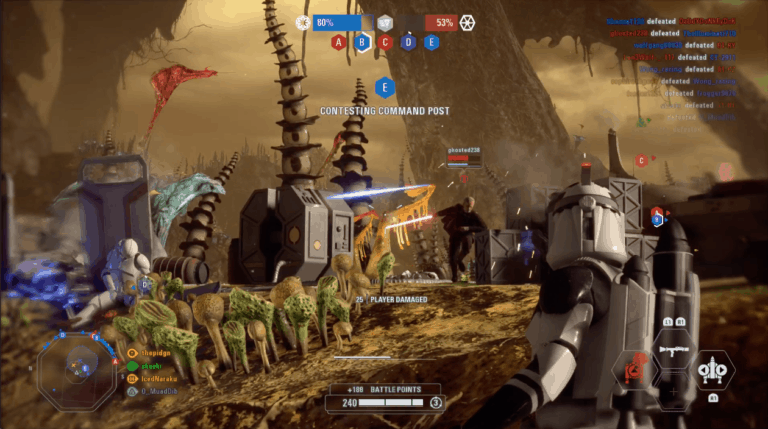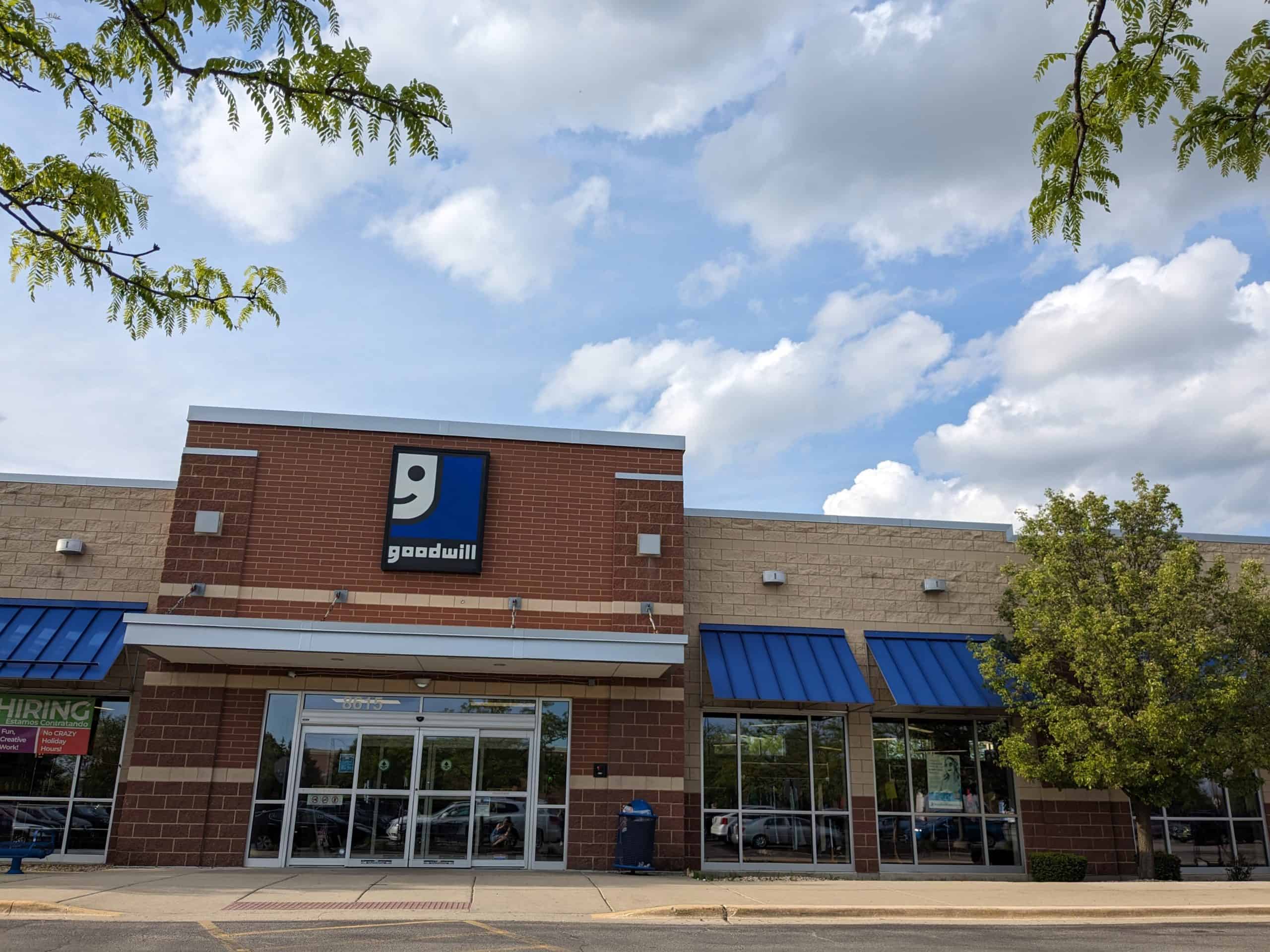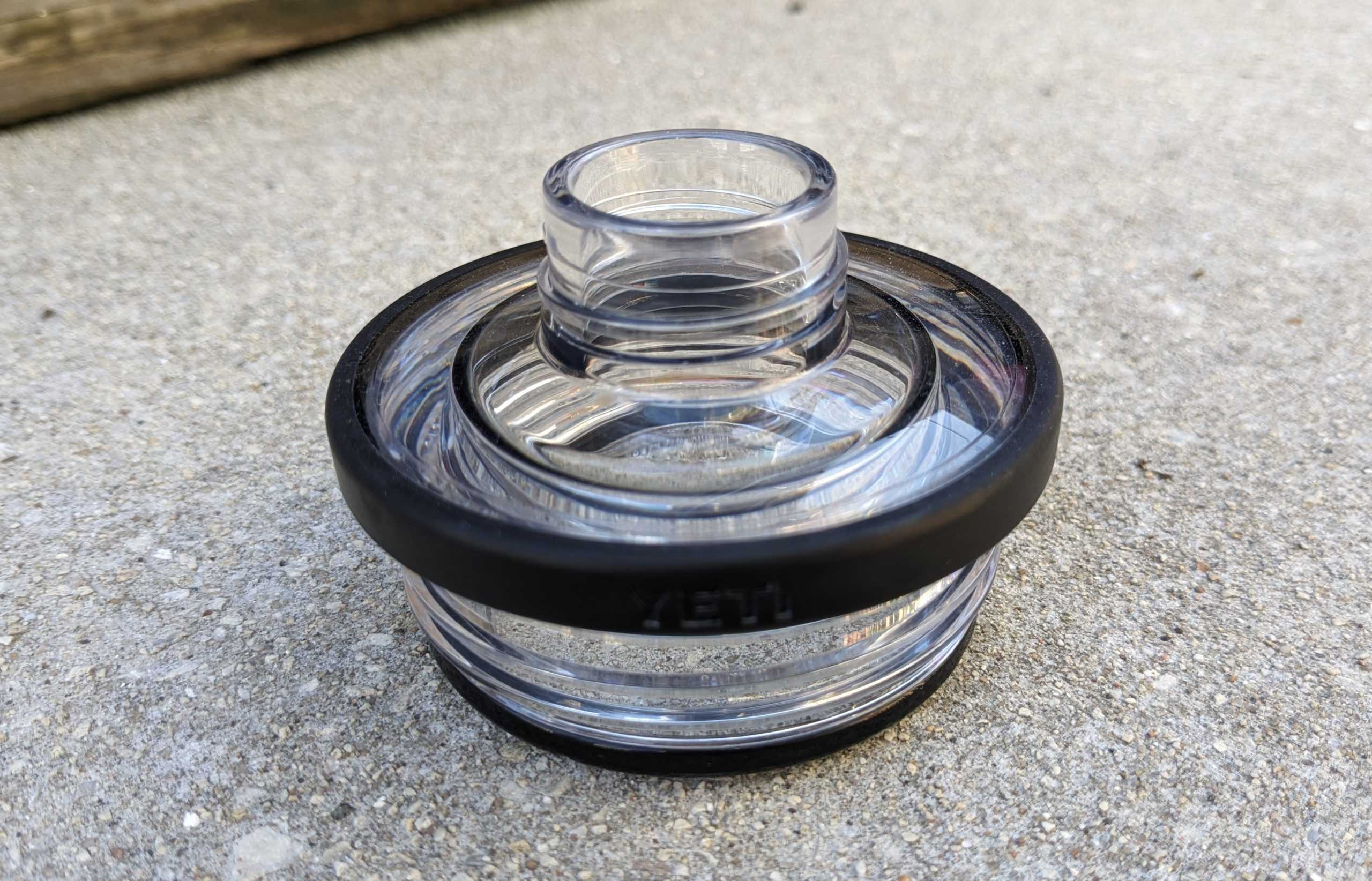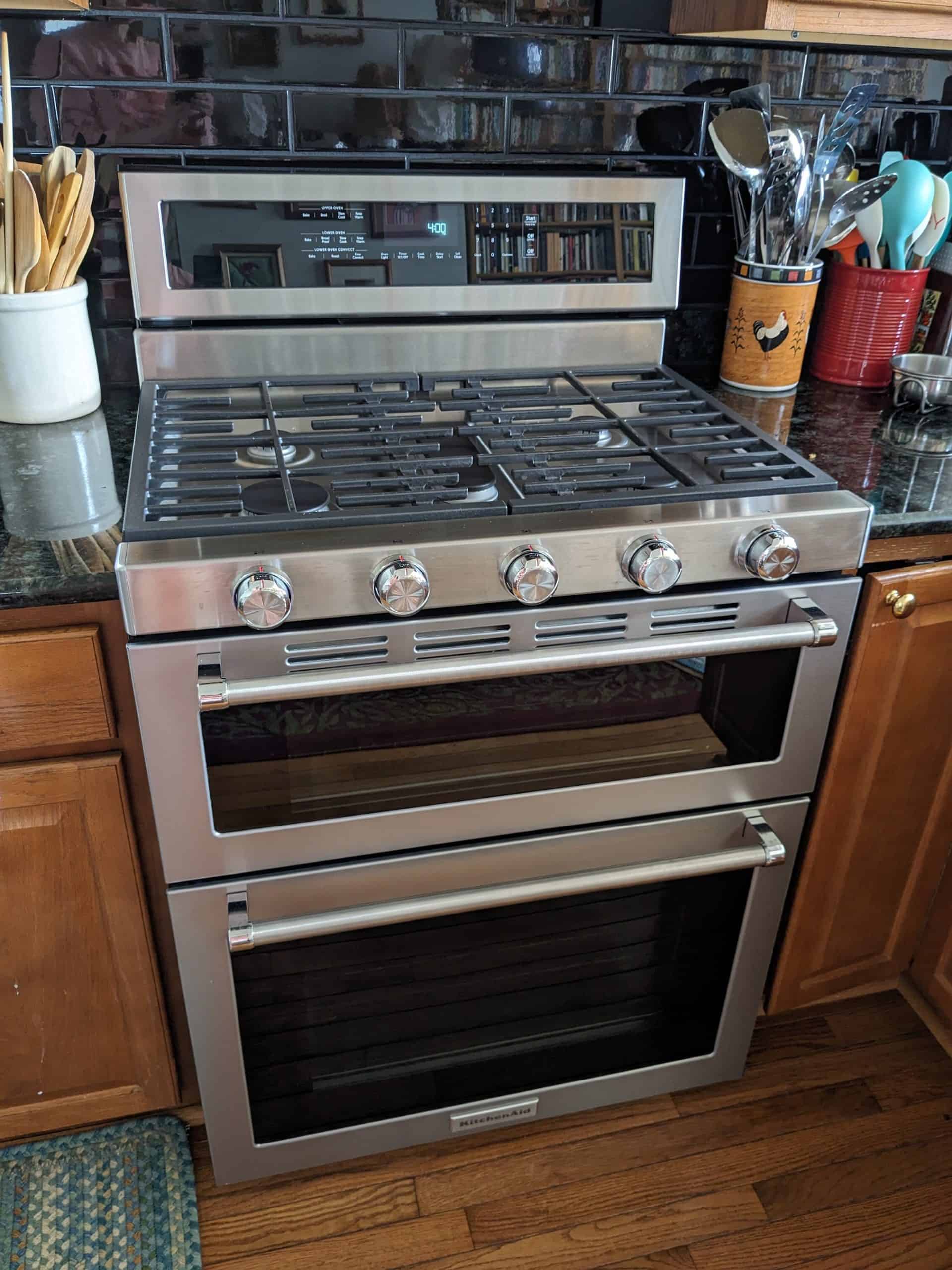If a time traveler visited me when I was in college and told me that in the year 2020, I would be eating Star Wars “Rebel Crunch” yogurt while wearing my favorite Chewbacca shirt, I would have called him a liar and a lunatic. In those days, my favorite movies were Stalker, Yojimbo, Santa Sangre, and Woman in the Dunes. It was more riveting to see sand slowly bury a woman alive than to try to follow the talking robots, jive turkey teenagers, and lightsaber knocking in Star Wars. Every time the two of us try to watch a Star Wars movie, new or old, we fall asleep on the sofa. I never understood what all the fuss was about—until we played Star Wars Battlefront 2. This game has made Star Wars fans out of us.
Allow me to paint a picture of what this game looks like to the uninitiated—those like myself who haven’t the foggiest about “The Resistance,” “General Grievous,” or “Wookies.” You open the game for the first time and select Supremacy, the 20 versus 20 PvP mode. Let’s say you’re assigned to the droid faction. Droids are thin, spindly creatures with narrow heads and lilting, computer-generated voices. Along with your 39 teammates, you spawn on some alien planet, let’s say Geonosis. Like an enormous, ravenous pack of summoned skeletons from Diablo 2, you and your frail, identical, insect-like teammates rush into the swirling desert dust.
Supremacy maps have five objectives to capture or defend. Your team captures the two points nearest their default spawn point. Then they voyage toward the middle of the map, to the highest objective, located on a towering landform eroded by wind. Here you catch your first glimpse of the enemy.
Far below your feet, pure-white, muscular humanoids crouch and roll, bouncing like ping-pong balls between space debris around a distant objective. They look like gym bros dressed for a white party. Periodically they form clusters and trickle toward your position, only to be rebuffed by sniper bullets, grenades, and—what’s this? From a shadowy hollow emerges a seven-foot-tall robot with four arms.
He jumps an impossible distance—20 feet through the air—with all four arms outstretched. In each hand is a glowing lightsaber. He lands near four enemy troopers. They scatter. Two roll toward a rock formation; that proves fatal. The robot begins to spin his sabers. He pins the two unfortunates against the rock and churns them to bits. Blaster fire rains on him, but the spinning sabers deflect it. He dashes away and disappears.
Now the composition of both teams has changed. Players on both sides have perished and respawned as different classes. Giant, broad-shouldered droids with no heads launch missiles and spray automatic weapons. Your side’s four-handed lightsaber robot is engaged in a brutal 1v1 with the enemy’s hero, a robed fella with floppy hair. Two gargantuan, armored spaceships have begun to bombard a nearby objective with explosive shells and lasers.
An enemy trooper with a jetpack jumps off a distant fairy chimney, flies across the sand, and in the blink of an eye reaches your cliffside hideaway. Hovering behind a teammate’s back, he launches a rocket. A mangled hunk of metal that was once a droid skips across the sand like a tumbleweed.
Across the map, twenty unique feuds, skirmishes, and conflicts are unfolding. Help yourself to this buffet of chaos, Battlefront 2 seems to say. Which scenario will you participate in, and how will it help your side win?
Tons of Game Modes. Tons of Classes. Loads of Builds. Choose Your Own Adventure.
Buffet. Cornucopia. Smorgasbord. A delightful excess. These are the words that come to mind every time I try to describe Battlefront 2. I’ve already mentioned the pandemonium of the largest game mode, Supremacy, where robots, troopers, AI bots, armored tank vehicles, flying troopers, powerful melee combatants, and other bizarre personages create microcosms of destruction. Behind that buffet of chaos lies the cornucopia of Battlefront 2 characters and builds.
The game includes four base classes, called “Troopers,” with several unlockable guns and swappable “Star Cards.” Star Cards allow players to change a class’ base skills and passives, creating a custom build. All classes can equip three unique Star Cards; each Trooper has 17 options from which to choose. Unlocking, testing, and discussing the pros and cons of each card has been an enduring Battlefront 2 adventure for us; we’ll be posting a Trooper Star Card article soon.

Troopers are the meat of the game, but there’s also three “Reinforcement” classes. Don’t take that to mean there’s just three playable Reinforcements, though. Rather, there are a whopping 19 Reinforcements: seven “Enforcers,” six “Infiltrators,” and six “Aerial” types, each with a unique weapon and skills. Here’s a gameplay vid with an Enforcer called the Clone Commando.

For vehicles, there are 22 playable options, including Starfighters, Hero Starfighters, and land vehicles that can be used in Supremacy and other ground-combat modes.
Of course, there’s the Heroes—22 of them. Heroes aren’t just famous lightsaber Jedis. Some, such as Lando Calrissian, Captain Phasma, and Bossk, use powerful blasters, while Emperor Palpatine, BB-8, and other singular Heroes use weapons and abilities found nowhere else in the game.
Who cares if there’s so many characters? Are they fun to play? Are they powerful? To that I direct you to some comments from this Battlefront 2 forum thread, “The Flame Trooper is the Most OP Enforcer in the Game.”
“Everything is op,” tommytom64 writes.
“You are a true philosopher. The above statement is the essence of over [a] hundred threads in this forum,” Qui_Gon_J1nn_n_Juice writes.
We at Co-Op Gaming Dot Info agree. Battlefront 2’s classes are, for the most part, OP as all get-out. Take your pick from this cornucopia of OP characters. This game can be a shooter, a fighting game, or a space-flight simulator. How do you want to play?
Choose from an overwhelming, bewildering, awe-inspiring, truly massive smorgasboard of game modes. You can play PvP in 20 versus 20, 10 versus 10, eight versus eight, four versus four, or two versus two. There’s deathmatch modes, territory-control modes, and modes that require you to steal a package or complete a series of mandates. Some modes utilize just Hero classes or Hero Starfighters; others take characters and Starfighters from across Star Wars factions and eras. Here’s a match of Heroes vs Villians, the 4v4 Heroes-only mode:

You can play PvE co-op in a group of four against AI enemies. You can play the single-player campaign. You can play in “arcade mode” and use just the classes you want, with custom difficulty and other game settings. You can even play split-screen co-op, teaming up with a buddy against AI in combat scenarios, or dueling in arcade mode with your own parameters. There’s even a mode in which one player starts as an Ewok (some kind of chubby, hairy, rabid critter) and then attempts to turn all the other players into Ewoks by stabbing them with a tiny spear.
Battlefront 2 presents its lavish buffet to any player who turns on the game. Browsing the menus, you get hungry. You want to try every class, every weapon, and every game mode. You want the best build, the most fun, and the highest position on the end-of-match scoreboard. Getting there is a lot of fun.
Supremacy Is Structurally Similar to ARPGs
If you’ve read the articles on this site, you probably know that we typically play fighter games and ARPGs. The PvP game we played the longest was the MMORPG ESO, in the large-scale “Alliance War” in Cyrodiil. Since our Cyrodiil days, we’ve tried PvP in Apex Legends, Warframe, Fortnite, For Honor, Red Dead Online, Naruto to Boruto: Shinobi Striker, Overwatch, Fallout 76, and a few other games. Some had great combat, but their formats didn’t appeal to us.
We’ve been playing Battlefront 2 for four straight months, and we’re still excited to turn on our Playstations and every night. Battlefront 2 might seem nothing like ESO or any of the games we typically play, but beneath the surface, it’s got everything we love. Structurally, Supremacy—and Battlefront 2’s co-op PvE modes—have more in common with ARPGs such as Path of Exile or Diablo than the usual AAA PvP shooters.
In Diablo II, there are four versions of monsters: Normal, Champion, Unique, and Super Unique. (Technically, bosses are Super Unique monsters.) Diablo II monsters appear at random throughout the map. Usually they’re found in groups. Traveling the wilds of Diablo II, players clear groups of monsters, taking extra care with dangerous Unique and Super Unique clusters. Grinding through hoard after hoard of monsters as fast as possible is the pleasure of a game such as Diablo or Path of Exile.
I’ve mentioned the three Battlefront 2 class types: Troopers, Reinforcements, and Heroes. These are roughly equivalent to the monster types in a game such as Diablo. Troopers are Normal monsters, with low health and limited skills. Reinforcements are like middle-tier monsters; tougher than Troopers, but a Trooper can take one down. And Heroes are like Super Unique bosses. Only four (two for each side) are allowed on the Supremacy battlefield at any given time. (More later on the topic of Heroes.)
In Supremacy, when you die, you have the option to spawn on an objective your team holds, or spawn on a teammate. The result? Players spawn in groups. When the monsters are players, I suppose we call them zergs. The largest zergs swarm enemy objectives. A single player wandering on his own will quickly turn into a small mob if you don’t take him down before his teammates spawn on him.
At the beginning of a Supremacy match, everyone is a Trooper. As the match progresses, the tougher mobs—Heroes and Reinforcements—begin to cluster-spawn. Sure, you’ve got to capture and defend territory in Supremacy, but your job is, at its core, to wander the map and clear ever-expanding, ever repopulating zergs of low- and high-level monsters. The faster you clear the mobs, the more you limit their territory. At the end of a truly unbalanced Supremacy match, the winning side will push the losers off every single objective, all the way back to their default spawn point. The winners put an end to the losers’ rhizomatic repopulation. The losers have been completely contained.
Booting up Supremacy and seeing the map fill with seething enemy mobs never gets old, just like in Diablo or Path of Exile.
The More Evasion The Merrier: We Love Dodge Roll
What do Rainbow Six Siege, Destiny, Apex Legends, Plants vs Zombies, Fortnite, and Overwatch all have in common? No dodge roll. Shooter games tend to include a “crouch” mechanic. Fighting games are the provenance of dodge roll; you expect to dodge in Dark Souls and Monster Hunter, for example. With its melee-combat lightsaber Heroes, Battlefront 2 had to give us dodge-rolls.
Some Enforcers get faster or more numerous dodges, and Aerial classes get a fire-powered jetpack dodge. How do these speedy dashes and somersaults change the gameplay and decision-making? Nathan Grayson, a senior reporter at Kotaku, wrote a bit about dodge rolls for an article called “Dark Souls’ Dodge Roll Would Get You Killed In Real Life:”
[Dodge roll] is not just an avoidance technique in games. It also covers distance, allowing players to reposition themselves in a big way or even briefly disengage from combat entirely. This makes for a greater range of possible tactical maneuvers and—on top of that—players can move out of striking range and readjust, rethink their attack plan, if need be. Combat can be overwhelming. The dodge roll is a remedy to that.
Duck-roll is a movement mechanic. More movement equals more evasion, more defense, and more surprise in every combat situation. In a game where you can only crouch, meeting another player outside of cover is a fast-draw duel. When you can dodge-roll, speed and aim must work with timing, foresight, and positioning. If evasion in a shooter-plus-fighter game doesn’t sound all that entertaining, I hope this gameplay clip from Reddit user SquidwardsJewishNose can convince you.
Whatever Your PvP Kink, No Shame From Battlefront 2
Are you a sneaky s.o.b who likes to kill players who never saw you coming? Several classes have skills that remove them from enemy radars or increase their movement speed, and Aerial combatants can fly through the air and drop enemies from behind. Sniper? Count on finding cliffs overlooking clueless players dawdling across an open meadow. Camper? Hang out at objectives, spawn points, or anywhere along the zerg stream and, without moving an inch, feed on an endless bounty of players.
These “classic” gunplay styles are well-developed in Battlefront 2, and you can live them to the fullest. But who gets excited about a shooter just because they can snipe, camp, or play aggro at close range? It’s the unusual playstyles that excite us. We want to tell friends about the weird stuff—the funny business—you can do in a game. Battlefront 2 has plenty.
In the second phase of Supremacy, the attackers’ objective is to destroy the panels on the defenders’ engine cores. If you’re an attacker assigned to the droid faction, you’ll have the option to play as the Droideka. This robot pulls himself into a ball and travels considerably faster than anyone else. That ball can also jump.
So you turn into a ball and start rolling. All entrances to the engine room are stuffed with defenders. Your team is at a standoff with these guys. Both sides are tossing grenades, sniping, and spraying each other with bullets. You roll, at breakneck speed, directly into the defenders. Some shoot at you. You jump. Most of their bullets miss—you’re too fast for them to hit. You roll faster. As you roll past some players feet, they don’t even react. They’re stoned, or you’re too fast, and they never even saw you.
You’ve passed their line of defense. You’re inside the engine room. The engine cores are connected by long, narrow gangways. Some defenders are stationed along the gangways and around the cores. Now your mission is to roll down these gangways until you find a place to hide.
At this point, Battlefront 2 is somewhat like a racing game. If you fall off the gangway, you die. If you roll too slowly or linger in one place, bullets will land. So you roll, as quickly and accurately as possible, down the gangways, jumping now and then to thwart stray bullets. If you reach cover behind an engine, you must kill any defenders who pursued you. Then you’re free to take down the cores. If you remain unnoticed, your teammates can spawn on you, circumventing the defenses at the room’s entrance and taking down the ship lickety-split.
Here’s another example. Let’s say you’re playing Supremacy in the First Order Resistance War era (meaning one side is the First Order, and the other is the Resistance). You’re going to be fighting a ton of All Terrain Scout Transport, or AT-ST, vehicles, which are a playable option from this era. That’s because the AT-ST is a beast. It’s a two-legged “walking vehicle” with 1,000 health and a weapon that does 300 DPS (while most Troopers’ base health is 150.) You can count on both Resistance and First Order players to hop into these death machines as fast as their Battle Points allow.
As soon as the AT-STs begin to spawn, they gain crazy power and influence. Trooper hearts tremble at the sight of an AT-ST. Taking the time to fire a couple rounds into one of these armored monstrosities is usually a death sentence; you can’t take it down before it turns its 300-DPS gun on you. Troopers hunker down behind four sides of cover, or they flee into the woods, abandoning their teammates, the objective, and their self-respect. A single AT-ST can hold a point for a long time—two AT-STs can hold one for eternity.
Unless they meet an Ovissian Gunner. This Resistance character has a rotary cannon with an anti-armor mode. Its bullets chew through vehicles like termites in a wood-frame building. If you’re assigned to the Resistance, you can play the Ovissian Gunner and systematically hunt AT-STs. Now you’re playing Battlefront 2 like an assassin. You’ve got your target. You’re out to wipe their kind off the face of the earth. Huge, armored, walking vehicles are easy to spot, and your rotary cannon bullets travel far. Like a vengeful sprite, you rove the map destroying one AT-STs after another, dishing out sweet punishment to the biggest, toughest, tankiest players.
There are countless other singular and entertaining ways to play Battlefront 2. You can create a melee-based Specialist build in which you clothe yourself in a giant, blaster-deflecting bubble and punch other players to death. You can abandon your defender duties in the second phase of Supremacy, and instead sneak through the ship’s rooms and tunnels until you reach the attackers’ spawn point; there, you can play the tough-guy, the troll, and murder innocent, unusupecting players who just spawned. You can be the guy in the AT-ST. You can be the guy who takes down every freaky rolling Droideka. Battlefront 2’s playable characters and game modes are so diverse, it’s hard to imagine not finding a playstyle to love.
Lightsaber Heroes: Deadly Bosses And Our Role Models
Heroes are deadly. Their lightsabers can block and deflect blaster fire. Most receive health on kill to augment their bloated health pools. They have improved movement speed and an enhanced jump, which allows them to float through the air and land on cliffs and platforms inaccessible to the masses. It only takes two lightsaber chops to down a Trooper, and many Hero abilities one-shot a Trooper. Here’s a video of Kylo Ren pretty much single-handedly taking Objective C in a Supremacy match:

Skilled players playing Heroes in Supremacy or Galactic Assault are comparable to bosses in Dark Souls. Only perfect evasion—taking no damage at all—will ensure the survival of your creaky droid or thick-bodied Stormtrooper. To counter and destroy enemy Heroes, Troopers must treat a Hero like a final boss in a dungeon. They have to work together to take him down. They have to strategize, to draw him out of cover and into the open. If players avoid a Hero or fail to kill him, he’ll rampage across the battlefield, taking one objective after another and leaving a trail of bodies in his wake. Solo-killing a Hero always feels like a triumph.
In each game mode, a limited quantity of Heroes and Reinforcement classes are permitted on the battlefield at any given time. In Supremacy, each side is allowed two Heroes. How does a player become a Hero? Each hero and reinforcement character has a Battle Points “price tag.” Battle Points are earned by eliminating enemy players, attacking and defending objectives, and “team play,” such as buffing or protecting teammates. When the match begins, so does the race to 4,000 Battle Points—the price of a Hero. When two heroes are already in play, players will not be able to select a Hero class even if they have 4,000 points to spend.
It’s tough to grab a Hero, but it’s also tough to play one. Heroes are marked with a circle on every player’s minimap. Everyone sees that circle coming. Often, enemy Heroes playing side-by-side will rush across the map to 2v1 your side’s Hero. Just a second observing a Hero is all it takes to determine whether he or she is trash. How efficiently he moves, how many skills he wastes or misses, how quickly he kills, and what combat situations he enters or exits tell a simple story. Those who have not mastered their chosen Hero class will find themselves turned into rubble in less than a minute. Here’s a video of two harmless beginner Heroes going down fast:

The last Star Wars Battlefront game used a “pickup” system. Anyone could transform into a hero by collecting a Hero token. The new Battlefront 2 system is just less fun, at least that’s what Forbes writer David Thier argued in this 2017 article, 3 Ways ‘Star Wars Battlefront 2’ Is Way Less Fun Than ‘Star Wars Battlefront’.
“ . . .it meant that anyone could grab a fun toy if they were in the right place at the right time, which felt like a welcome change from the scorestreaks of Call of Duty that give the best players in the game even more ammunition with which to make everyone else’s lives miserable. . . It used to be I would get excited to drop into an AT-ST when one presented itself on the battlefield: now I’m just stressed out that I’ll waste my points getting blown up.”
Is Battlefront 2’s system less “fun” than the original token system? Definitely. It’s unquestionably more fun to find a $50 bill on the ground than to work minimum wage for six hours and earn that same $50. Rather than thinking of instant fun and gratification, consider motivation, reward, and achievement. Over the course of the months we’ve spent playing Battlefront 2, we enjoyed the game’s Hero system—not because we evolved into God-tier lightsaber warlords, but because the excellence the system demands and the rewards it dishes out are great motivation.
As a beginning player, if ever you’re lucky enough to grab a Hero slot in Supremacy, there’s no time to test that Hero’s abilities, or analyze the finer points of their movement, stamina, and block mechanics. Instead you’re dropped into the throes of deadly combat, squaring off against hordes of enemy players and more experienced enemy Heroes. It’s painful to spend your 4,000 points and get merked. And when you’re playing a Trooper, getting destroyed by a level 500 lightsaber Hero always stings. (Especially when Rey, who has a skill that removes her circle from your minimap, sneaks up and clobbers you, and you never saw her coming.)
How can we avoid this pain? Simple: git gud! These two sources of punishment force us, as novice players, to immediately confront the true scope of the game, a topic we discussed at length in our article about Dauntless. Powerful lightsaber players show us what the end-game, the pinnacle of achievement, looks like. They make us want to get there. We want to learn how to play against them, and to play as them, without getting killed. We crave this almighty power!
The gulf between a trash and expert Hero doesn’t just motivate the trash. It also keeps experts happy. An excellent player can quickly accumulate 4,000 points. He can hit “respawn” and become a Hero; accumulate another 4,000 points or more; die; wait five seconds; then select his hero again. If nobody steals his hero (or if he never dies at all!), he can play as his chosen hero for the entire match.
Of course, it takes drive and dedication to monitor your points and attempt to out-spawn other players. Typically the two of us are too slow-moving and engrossed in our petty gunfights to try it. We can’t say how many Battlefront 2 players regularly attempt to come in first at the Hero-spawn mini-game, but we do fairly frequently see the same player playing the same Hero for an entire Supremacy match.
Even if it’s tricky to perform or mainly theoretical, playing as your favorite Hero for a prolonged match against mostly Troopers is a fantastic reward. It’s like getting to play as the boss. We can think of plenty of prodigious ESO players who would jump straight into Battlefront 2 if they knew how the Hero system would reward their video game skills.
If you put in the time to “git gud” in Battlefront 2, or any video game, you want something to show for it. If it’s a PvP game, that “something” is usually the ability to mercilessly slaughter hordes of incompetent players, with an occasional duel with a fellow pro on the side, of course. PvP devotees want their skill and experience to catapult them far above the other players’ heads, into the heavens, at God tier, guaranteed. They crave “even more ammunition with which to make everyone else’s lives miserable.” A game that can provide that—in a fair, controlled, and balanced format—is alluring indeed.
Stress-Free Group Play: Freedom of Choice, Limited Healing, No Res, Quick Death, & Quick Respawns
We at Co-op Gaming Dot Info play every video game together. John is enormously more skilled at video games than Genevieve. When we play PvP games together, our differing skill levels often cause conflict. In games where teamplay is crucial in each second, novice mistakes torpedo the entire team. In Battle Royale games, each player has only one life—if Genevieve dies, John is left to finish the round on his own.
Collectively, we’ve died more in Battlefront 2 than in any other game. When you gaze out across a Supremacy map, there are so many enemies that only a computer could perfectly track them. Some sneaky motherfucker can always take you completely by surprise. Yet our Supremacy nights never end in rage, disappointment, and hurt feelings (The same cannot be said when we play 4v4 in Heroes Vs Legends, but that’s another story.) There are a couple reasons it’s hard for Supremacy, Galactic Assault, or the majority of the game’s modes to exasperate us.
First, group-play is profitable, not mandatory. Supremacy, like Battlefield’s 20v20 game mode, groups players into teams of four within each 20-man faction. The two of us always play with two randoms. Anyone in the group can mark an objective they’d like to defend or conqueror, but that feature isn’t regularly used. If teams stick together, their power to capture or defend an objective increases—but maps are large, and there’s no pressure. Aerial players and players in vehicles are far more mobile than the average Trooper or Reinforcement, so their teammates can’t even follow them across the map. This creates an easy-going system in which each player can do as he pleases; his decisions are his own. Tight-knit groups can get things done for their side, and solo players parked in their favorite sniping spot can make things happen, too. This freedom of choice was one of the things we most prized about Cyrodiil in ESO.
Next, healing in Battlefront 2 is scarce. You can’t find it in a bottle on the ground. You can’t expect to get it from a teammate. You have to work for it. There are tons of sources of healing, but they’re all underpowered, conditional, or entirely optional—meaning you have to choose them as your build. Health-on-kill, for example, is readily available as a Star Card. If you’re counting on health-on-kill as your heal, you better be getting kills. Among Trooper classes, there’s only two healing skills. The one real group-heal in the game—the Officer’s “Battle Command”—adds a temporary 100 points of health to all players within its cast radius. The key word here is temporary. The “heal” lasts less than 20 seconds; it’s more like a buff. That’s how the majority of the game’s “heals,” including Enforcers’ “Fortify” skills, work. They could save your life, but only if the timing’s right.
The one source of healing every player can access is health regeneration. After a Trooper takes damage, his health will begin to regenerate after 6 seconds. Regen delay is different for each class, and can be buffed with the right Star Cards, but as long as someone’s shooting at you, you can’t regenerate health. Completely exiting combat is the only way to fully refill your health bar.
These finicky healing options don’t come close to matching the damage output of the Battlefront 2’s blasters, lightsabers, and explosions. Depending on your gun and range, it only takes one or two headshots, or a moment of focused fire, to kill a Trooper. Nobody in this game can out-heal well-placed headshots. There are no ludicrously sturdy tanks, nor ridiculous heal-bots. Everybody dies, and everybody dies fast. Even Heroes go down quickly if everyone’s shooting their heads. Survival is usually a result of a decision you made the moment before you entered combat, not your build or gun.
In Battlefront 2, players cannot resurrect one another. There is no corpse camping. Players can’t sneak off to res their groupmates and continue trolling a portion of the map. If you wipe a group out, they’re gone. And if you’re beaten, you don’t sit in front of your blank LCD screen hoping for a teammate’s pity, a second chance, and the opportunity to teabag the corpse of the guy who beat you. You simply respawn. You move on to the next life.
This comes to the final reason Battlefront 2 is fun for players of all skill levels: there’s no downtime. Everyone’s always playing. After you die, it only takes about six seconds before you’re back in the game. A crappy player isn’t ejected from a match. He doesn’t return to the queue to linger in a loading screen. He instantly receives a second chance. Playing Battlefront 2 blows the lid off this source of video game rage—wasted time. Not playing makes us unhappy. Sitting around doing nothing, chasing some unkillable enemy, and staring at other players makes us unhappy. As long as you’re hitting buttons and controlling your toon, it’s hard to get pissed off.
No Loot, No Crafting, No RNG, No Homebase, and No Meta: A Fresh Breeze Blows Through Battlefront 2
Though there are some collectibles in Battlefront 2’s single player campaign, there’s no loot to collect in multiplayer modes. There’s no inventory to manage. In its current iteration, the game includes no crafting: no deconstructing junk items or hoarding materials. There’s no armor to upgrade. There’s no RNG on guns in Battlefront 2—each class has access to the same weapons and weapon mods, which unlock as you play that class. Best of all, there’s no abominable “homebase” to which you must perpetually return to chat with NPCs and while away the day scrolling through upgrades, quests, and story snippets.
Naturally, Battlefront 2 isn’t the only PvP game that spares players this time-consuming and soul-sucking menu hokum. However, in its current iteration—with loot boxes, Star-Card crafting, and paid add-ons completely removed—Battlefront 2 feels even cleaner than its cousin Battlefield or the popular playboy Overwatch. When you turn on Battlefront 2, it feels like there’s nothing to do but get into a match and play.
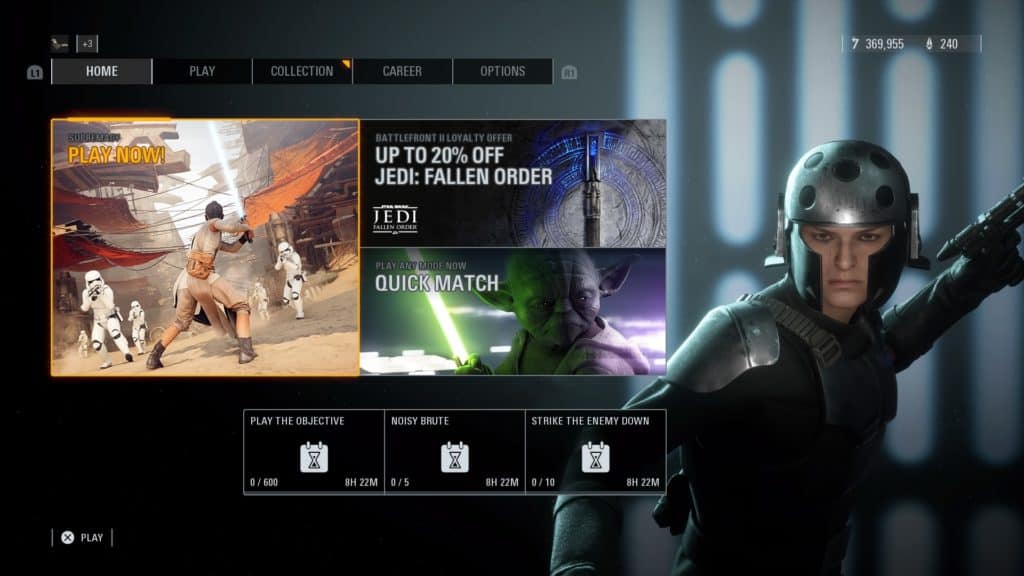
We criticized that very phenomenon in our review of Naruto to Boruto: Shinobi Striker. In Naruto, you could unlock everything in a month or two; after that, there was nowhere new to go with your character, other than tweaking your build or unwrapping an occasional “scroll” reward to update your gear. There was nothing to do but play the game, and improve with your class and skills. Why did that feel glum in Naruto, but liberating in Battlefront 2?
Naruto only had four classes, with somewhere around 100 skills. Battlefront 2, as I’ve already mentioned, has far more than that—67 playable characters with more than 200 skills, by my count. The sheer quantity of classes and skills isn’t what keeps Battlefront 2 feeling fresh, though it certainly helps. Battlefront 2’s format motivates players to learn and master all its classes and skills. Naruto’s doesn’t.
Like many PvP games, Naruto had a hard, heavy meta. Healers and Defense-type ninjas dominated. By comparison, other classes were weak. Every player wants the most deadly and effective PvP skills, weapons, and gear. In Naruto, there was no reason to grind XP to unlock some worthless Ranged ninja skill when your Defense main was already simply the best.
Battlefront 2 prohibits players from sticking with the same thing by setting class limits in each game mode. Everyone can’t play the same OP character at the same time. The more powerful the class, the stricter the in-game limit. Even if everyone agrees that Anakin Skywalker is the dope Hero, only one Anakin is allowed in any Supremacy match. You might find yourself assigned to the Dark Side rather than the Light Side; the Dark Side has its own set of Heroes, so you won’t even have the option to play Anakin.
You and your teammates can choose classes or Heroes whose abilities synergize with each other, but there’s no one character or team build that’s always “the best.” As players die and select new characters for their respawn, the composition of teams changes. From one moment to the next, power dynamics evolve.
The huge selection of game modes helps fulfill our desire to master new classes. Getting into the game, you quickly level your favorites past 100. Heroes, Starfighters, and Reinforcements you didn’t often play stagnate below level 20. When you want to learn them, you consider which modes would give you the most play-time to level them fastest. You get deeper into Battlefront 2; you try more new Battlefront 2 things.
Video games are always the most fun when we’re learning and discovering new ways to be successful. We players are reluctant to change if we’re already mighty. Every time you die in Battlefront 2, you’re forced to evaluate the match’s situation and choose which class to next command. The more flexibility you have in your skill repertoire, the better. You make your choice and embark on a new adventure. It’s instantly refreshing.
Don’t Sell Me A Dog: The Current State of the Game And The True Evil Behind Greedy EA’s Original Starvation Economy
We started playing Battlefront 2 around Christmas 2019—two years after the game’s release. In 2018, loot boxes and their reprehensible offerings were completely scrubbed from the game. Today, progression is linear. Players continue to earn Credits at the end of every match, but there’s nothing to spend them on except old cosmetic skins. There’s no in-game economy to speak of.
We love Battlefront 2 in its free-for-all iteration. As current players, we’re invested in Battlefront 2’s future. We have to ask ourselves if the current state of the game only temporary. Will EA continue to support Battlefront 2 if it’s not netting FIFA-level earnings? Will EA someday rework Battlefront 2’s economy to milk players again? Did the public outcry and brand damage cause permanent changes to EA’s corporate philosophy?
Nobody knows the answers to these questions. Today, we’re recommending Battlefront 2, but none of us want to dole out weekly cash to EA like FIFA players. Thousands of players are justified in saying they’d never touch Battlefront 2 with a ten-foot pole, no matter what changes EA made. One thing is certain: the two of us wouldn’t have played this game at launch.
The evil in-game economy buried the best things about Battlefront 2. The cornucopia of playable characters was locked down. You could buy your way out of the process of leveling classes and choosing their builds and weapons. The buffet of game modes may have been intended as add-ons, though EA never made that clear.
What follows is an attempt to summarize the original game economy. Why include this in today’s review? First, in-game economies are always fascinating. We love to study the way game creators manipulate players for profit. Sites such as Kotaku that heavily covered the day-to-day Battlefront 2 controversy missed the bigger picture about the game’s economy. Second, if you start playing the game recently, like we did, you’re going to have a lot of questions. Today’s Battlefront 2 bears little resemblance to the original. You’re going to get curious about the how things you see in today’s game functioned at launch. We wanted a complete explanation in one place.
It is extraordinarily difficult for someone who didn’t buy the game at release to pin down all its nuances. Almost as soon as the game launched, there were changes to the loot boxes and crafting systems. We pieced things together from old articles and Youtube. If you played at launch, let us know if we’ve missed something or gotten something wrong.
In EA’s original Star Wars Battlefront 2 system, a new player would open the game and find all the game’s “assets”—Hero classes, Star Cards, weapons, and weapon attachments—locked. Each asset had a unique unlock path and “price.” There were two currencies, Crystals and Credits. Crystals were purchased for real-world currency. According to this November 2017 GameRant article, the cheapest Crystal bundle gave you 12,000 for $99.99—about 1.2 Crystals per penny. Credits were earned mainly by playing the game, from milestone achievements (such as “In multiplayer, defeat 150 enemies with the Heavy’s Sentry Gun”) and the player’s performance during matches, though small amounts could come from loot crates.
As we’ve already mentioned, players use Star Cards to design unique builds for their Star Wars Battlefront 2 classes. The original system gave players two ways to acquire Star Cards. The first was through loot boxes. Purchase a Hero, Trooper, or Starfighter box and the game just might give you that card you want.
The second method of acquiring and upgrading Star Cards was crafting. Crafting was designed to be, well, a real bitch. Rather than presenting a happy alternative to crates, crafting was deeply intertwined with the crate system. The ability to craft a card you wanted was gated by something called “Star Card rank,” which was determined by how many of that class’ specific star cards you already owned. This ensured a player couldn’t examine all a class’ Star Cards; decide which ones he wanted; and then craft only the cards he wanted. Instead, he had to first accumulate that class’ cards until his “card rank” was sufficiently high. Opening crates was the fastest way to accumulate cards.
Crafting also required “crafting parts.” Crafting parts could be earned by completing milestone achievements, but they were also found inside—you guessed it—loot boxes. According to this November 2017 GosuNoob article, each loot box could net players 45 or 60 crafting parts, and completing any class’ “Kill 20 Enemies” milestone achievement in Galactic Assault gave 50 crafting parts. Fandom’s crafting parts article lists the cost of crafting a Star Card at 40 parts; upgrading from Common all the way to Epic would cost a whopping 680 parts. So one Epic Star Card would come at the price of about 14 achievements. (At the very outset of the game, it seems that you could only upgrade a card to Rare; only loot boxes contained Epic cards. Now that loot boxes have been eliminated, there are no Epic cards in the game.)
Crafting Star Cards without opening any loot crates would have been some insane, idiotic process whereby you’d spend hundreds of hard-earned, achievement-based crafting parts to craft unwanted cards until your “Star Card rank” crafting ability was acceptable; and then you’d spend hundreds more upgrading the three desired cards to epic; in the end, getting your chosen build for any one class would cost thousands of parts—an impossible quantity.
Of course, nobody at EA intended for players to exclusively craft Star Cards with milestone-achievement crafting parts alone. Crates were the bread-and-butter of the game. Players were given one sign-in crate per day. Every time they played they earned credits, which could be spent on crates. The crafting system complemented, not replaced, the crate system.
Players with the most crates would have the most advantage in the Star Card system, the crafting system, and in the game as a whole. Designing a build for any class in Battlefront 2 was directly dependent on the quantity and quality of Star Cards and crafting materials received in the crates the player opened. Even weapons and weapon mods, which unlocked when you leveled up a class, also dropped as a rare item in crates. This is why the game was lambasted as “pay-to-win,” though the more accurate description is probably “pay-to-progress” or “pay-to-reach-endgame-power-in-the-early-game.”
Let’s move on to the Hero classes. Hero classes were not directly purchasable with paid-for crystals. Rather, only credits unlocked them. EA seemed to be saying, “Hey, you have to play the game to unlock these chic warriors, you can’t just buy them!” The credit “price” of both Vader and Luke at the game’s launch was 60,000 credits.
That required a staggering 40 hours of gameplay, according to data Redditor TheHotterPotato collected playing Galactic Assault during the EA Access period. Probably it took less than 40 hours; in his data, TheHotterPotato left out credits earned for completing achievement milestones, because everyone’s milestones are different. Forty hours was a baseline number, but still, it was insane. Many players crunched many numbers; you may have seen headlines like this one from Polygon: Star Wars Battlefront 2 Content Might Take Years To Unlock, But EA Won’t Say. You get the picture—the Star Card and Hero unlock systems worked together to make unlocking Battlefront 2 content something like climbing Mt. Everest.
How can we describe Battlefront 2’s in-game economy? An economy requires inputs in order to get outputs. In a starvation economy, there is an enormous mismatch in value between input and output. Imagine if it took 20,000 man-hours to create one eight ounce glass of water, or $60,000 worth of raw materials, and each human requires eight eight-ounce glasses of water per day. The result? Billions would die of dehydration.
We can all agree that forty hours of gameplay is a large input. We call the same amount of hours an entire work week. That input “outputs” 60,000 credits. Sixty thousand credits can buy you one Vader hero. Every Battlefront 2 player wants that Vader hero. He’s our water! The masses were meant to perish! (Star Card crafting and upgrading, as I’ve already mentioned, had a similarly unbalanced input-to-output ratio; Soeren Kamper of SWTOR Strategies calculated that upgrading every card in the game would require 4,528 gameplay hours.)
Of course, EA didn’t intend to starve us. They never wanted to make their delightful Battlefront 2 content completely inaccessible. More accurately, players were meant to make a tough choice in order to survive. You had Credits, and Crystals were on the table. You needed Star Cards and Heroes. How should you get what? There was only one right choice.
Only Credits unlocked Heroes. Save your Credits for Heroes! After all, it could take a week of non-stop credit-farming to earn one Vader! Use Crystals to get Star Cards from loot boxes. Buy some freaking Crystals.
This was the true evil of the old Battlefront 2 system. This was how players were meant to survive the starvation economy. At its core, Battlefront 2 prompted logical people to spend money. The most rational approach to getting what you want—fast—required having both Credits and Crystals, and spending both. If you didn’t abide by this sensible precept, every loot box you bought with credits pushed you further from unlocking a Hero.
“Brilliant!” Dr. Evil and EA CEO Andrew Wilson say, rubbing their hands together. But seriously, we at Co-Op Gaming Dot Info are grateful to all you players out there who played Battlefront 1, knew how awesome Battlefront 2 could be, and boycotted it due to its evil in-game economy. You made EA change the game. It’s awesome now. We can’t believe how clean a game can look with its bullshit systems stripped away. It’s invigorating when the mental energy of gambling—the hopefulness, the lusting over things you can’t have yet, the disappointment, and the wasted time—is absent from a video game.
It’s not just loot boxes that suck us into the cycle of anticipation, reward, and disappointment. The RNG on loot in games such as The Division and Ghost Recon Breakpoint uses the same emotional stamina. Playing Battlefront 2, we started to seriously wonder what we would have thought of Breakpoint if Ubisoft scraped off the game’s layers of complication. What if it had no loot and gear scores? No trite Erewhon home base? What if we didn’t have to spend an hour in the menus just to start playing?
What if we just shot the enemies? What if we just played the game? The big console releases of the last few years have made that concept hard to imagine. For now, Battlefront 2 is here to remind us.
